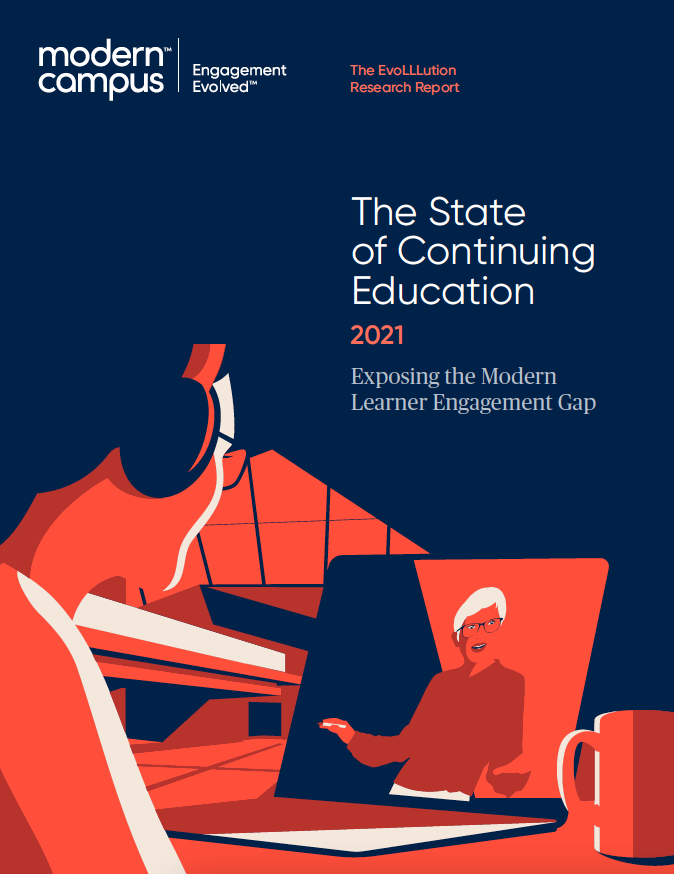2021 State of Continuing Education Survey Highlights Growing Engagement Gap
Ninety percent of higher education institutions are delivering subpar digital engagement—impacting enrollment and retention numbers—according to this year’s edition of the State of Continuing Education survey, developed by The EvoLLLution.
The annual State of Continuing Education survey highlights trends, challenges and opportunities shaping CE, which tends to serve as a bellwether for the rest of the higher ed market.
The key findings from this year’s research exemplifies a widening engagement gap between the expectations of modern learners and the colleges and universities who serve them.
The Engagement Gap is Exacerbated by a Lack of Technological Functionality
According to survey respondents, leveraging outdated technology tools and systems makes it difficult to deliver on the constantly growing expectations of today’s students.
Though 73% of respondents said that the institutional website should play a leading role in deeply engaging students and facilitating their registration, only 10% of respondents rated their site as “very effective” at driving engagement, enrollment and retention.
What’s more, only about one-third of respondents said their institution has the technological flexibility and functionality to deliver the experience non-degree students expect. Nearly 60% of respondents said they could only deliver on the high expectations of non-degree students by relying on significant manual staff effort, and 10% of respondents said their tech stack is not at all designed to support the needs of non-degree students or programs.
In fact, one anonymous survey respondent highlighted their lack of technological functionality as a severe obstacle to serving students during the pandemic.
“[Continuing Education was] rendered undeliverable since we do not have access to an online enrollment management system,” they wrote.
In some cases, this lack of technological capability is especially dire. About 31% of respondents said they couldn’t even pull a piece of critical business information—how many non-degree students they enroll—without asking multiple people (if at all).
Flexible Credential Models Provide Opportunities for Lifelong Learner Engagement
This year’s study also highlighted some exciting opportunities for growth on the horizon for higher education institutions. These opportunities also highlight the potential for much closer alignment between non-degree divisions and main campuses:
- Almost 80% of respondents said their institution plans to grow their portfolio of stackable credential offerings, which allow students to progress toward major credentials at their own pace while working.
- Three-quarters of respondents said their institution plans to grow their microcredentialing portfolio, expanding the array of sub-degree credentials—including certificates, certifications, and digital badges.
This shows that higher education institutions broadly are recognizing the opportunity provided by non-degree education, and aligns with some of the broader trends we’ve noticed across the industry in recent years. After all, a majority of adults considering enrolling in a higher ed offering say they prefer non-degree credentials, and degree enrollment industry-wide dropped by 3% in 2020 (despite the recession!).
However, the study also highlighted a gap between non-degree divisions and main campuses that needs to be addressed in order to truly expand stackable and microcredential capabilities.
A Gap Between Continuing Education and Main Campus
The 2021 State of Continuing Education survey highlighted a gap between non-degree divisions and main campuses that needs to be addressed by action—not just words.
Encouragingly, 76% of respondents said they had senior leadership buy-in to scale and expand non-degree courses and programs at their institutions.
However, when asked the major challenges standing in the way of non-degree growth, nearly 60% of respondents pointed to obstacles created or exacerbated by a lack of actionable support and investment from senior institutional leaders. Nearly 20% highlighted a lack of acceptance or support of non-degree education, almost 16% flagged a lack of staff capacity, 14% noted a lack of financial support and 8% pointed to inadequate technology.
“To really play in this space, you have to resource it,” said Rob Westervelt, vice president for strategy and innovation at Lindenwood University.

Serving Modern Learners Requires Active Focus on the Engagement Gap
The engagement gap between higher education institutions and the students they serve has been growing for decades, and widened due the COVID-19 pandemic and the recession that followed.
In order for colleges and universities to stay relevant and deliver the impact their communities demand, it’s essential for institutions to establish a new operational normal that positions them to meet and exceed the expectations of the students they serve.
Verbal commitments to microcredentials and stackable education is a powerful start, but it must be backed up by action and investment. That’s the only way higher education institutions can meaningfully allow their non-degree divisions to help them innovate and expand.
The State of Continuing Education 2021
The annual State of Continuing Education survey highlights trends, challenges and opportunities shaping CE, which tends to serve as a bellwether for the rest of the higher ed market.
Last updated: March 9, 2021



